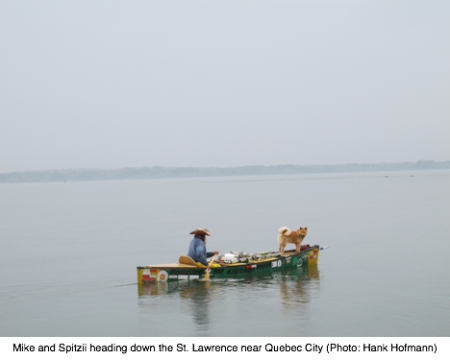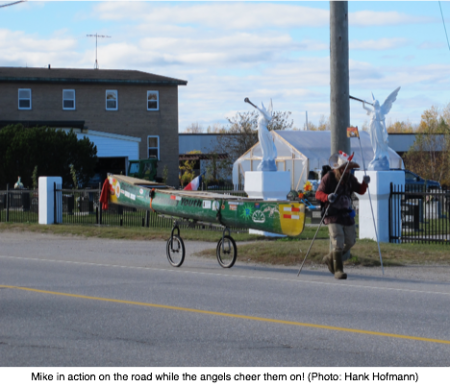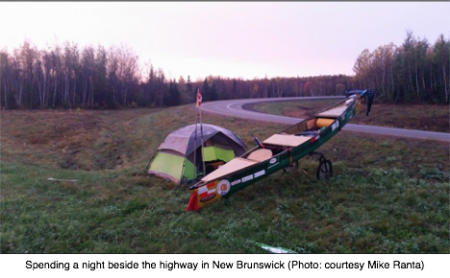Across the continent with a dog and a canoe
Seven months with a canoe and a dog. That’s how an adventurer from northwestern Ontario has spent a large chunk of 2014. Mike Ranta, a 43-year-old man from the small town of Atikokan, Ontario – the “Canoeing Capital of Canada” – has just completed the adventure of a lifetime by paddling solo across North America accompanied only by his dog, Spitzii. (Spitzii is a Finnish spitz breed of dog, hence the name)
Mike and Spitzii left Vancouver, British Columbia on April 1 and arrived in Tatamagouche, Nova Scotia on October 31 after travelling over 7000 km. Their route took them up the Fraser river, across the continental divide, through the Canadian prairies on the north Saskatchewan river, across Lake Manitoba and the upper Great Lakes, down the Ottawa river and the lower St. Lawrence and along the eastern coast of New Brunswick and Nova Scotia. Most nights they slept in a tent, sometimes at public marinas, often out in the remote wilderness and occasionally on the property of generous people they met along the way who offered them a secluded place to spend the night – and a meal. Courtesy of Mike’s GPS tracking locator, his actual route can be viewed here.
 The Guinness World Records organization is expected to certify this trip as the longest solo canoe paddle ever undertaken. And it marks the first time a solo paddler has ever crossed Canada from coast to coast by canoe in one canoeing season.
The Guinness World Records organization is expected to certify this trip as the longest solo canoe paddle ever undertaken. And it marks the first time a solo paddler has ever crossed Canada from coast to coast by canoe in one canoeing season.
So why would someone do something like this?
Mike has undertaken this trip in order to raise funds for a youth centre in his home town through a non-profit organization entitled Atikokan Youth Initiatives. And he has been spreading the word along the way about the importance of getting young people interested in exercise and outdoor adventure and showing respect for nature.
Equally importantly, crossing Canada by some means not involving an internal combustion engine (bicycle, horse, walking, wheel chair, canoe) has become somewhat of a right of passage in this country for a certain segment of the population. As someone who bicycled across Canada many years, ago I can definitely relate to that urge to prove yourself and see the country the way few others do.
I was fortunate enough to meet up with Mike on two occasions. With his large sombrero-style hat, colourful rain gear, large rubber boots, long hair and beard and booming voice, he certainly comes across as a larger-than-life individual. But he also impresses with his deep knowledge of the early history of Canada and its cultural traditions in each region he travelled on this trip. And, not surprisingly, his love for the country’s natural scenery comes through loud and clear.
Mike told me about some of his more hair-raising moments. These included a portage of over 200 kilometres along the trans-Canada highway through the Rocky Mountains in the snows of mid-April, paddling upstream on the Winnipeg River in Manitoba and northwestern Ontario against the fastest and highest water levels that river has seen since 1926, falling down a 15-foot cliff while portaging the canoe in Ontario and battling the tidal currents on the lower St. Lawrence below Quebec City – which finally caused Mike to portage by road again until he reached the Atlantic Ocean. And his last obstacles were the relentless swells and high winds on New Brunswick’s east coast which forced him to portage his canoe for virtually the entire length of New Brunswick – a distance of over 200 km (again!). He finished his trip one day before a major snowstorm hit the Canadian maritime provinces.
Then there were the encounters. One night on the prairies an aggressive pack of coyotes surrounded the tent yelping at top volume, apparently intent on attacking Spitzii. Only loud banging on pots and brandishing a paddle scared them off. Another evening, after a long paddle across a portion of Lake Superior, they approached shore to camp only to be met by a very large black bear who made it plain that that spot belonged to him (or her); a quick exit to look for another camping spot was the wise choice. On the North Saskatchewan river, they came across a dead body which they promptly reported to the local police (no word on how that resolved itself). In northern Manitoba, man and dog had a frightening, extremely close encounter with a lightning strike during a thunderstorm which left Mike with a ringing in his ears for a few days. And after landing at a camping spot near Quebec city, Mike got a lesson in tidal action when he had to go for an impromptu swim to rescue his canoe which the tide was slowly carrying out into the middle of the river. Read about his own account of 5 major “brushes with death” here.
But there was also the kindness of strangers. After Mike inadvertently left his wallet containing all his money and information in the wilderness at the end of a portage, another paddler coming through the next day found it and managed to get it back to Mike with more money in it than when he lost it!
You can listen to a CBC Thunder Bay interview with Mike on his last day of paddling here.
So what’s next for Mike. Well, he intends to write a book about his trip and, in 2016, repeat the cross-Canada adventure by way of a different canoe route!
Tags: adventure, Atikokan, canada, canoe, environment, Mike Ranta, social activism, travel












Wonderful article Hank! I enjoyed following Mike’s journey daily on Facebook. He made an amazing journey, that is for sure, and has been an inspiration to many! Thumbs up to Mike and Spitzii! You guys rock! 😀
Loved this, Hank! So good. Thanks for putting the story together.
A guy Bill Nedderman solo canoed in a canoe he built two years ago and covered 12,800 Kms in a continuous 12-month paddle trip fyi. Congrats to Mike Ranta…it may be the first crossing of “Canada” but NOT the longest solo canoe. Nedderman i the past has completed 4 other solo paddle trips that have exceeded 8000kms too.
AM